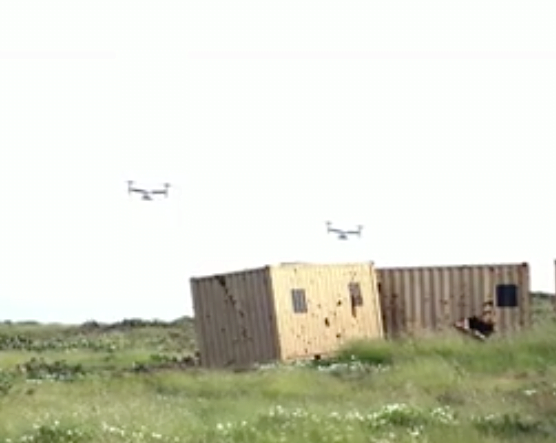2014-04-20 Marines with the Infantry Officer’s Course conducted a long-range raid on San Clemente Island, Calif., March 24.
The Marines were lifted approximately 70 miles off the coast of southern California by Third Marine Aircraft Wing and East Coast aircraft.
The Marines also used new technology to plan before boots hit the ground.
The exercise was conducted by the Infantry Officer Course paired with VMX-22 and the Ospreys were accompanied by a specially configured Osprey with an airborne communication gateway with a Wi-Fi network that linked the tables carried by the squads riding in the Ospreys.
The Cat Bird, the F-35 surrogate sensor aircraft, sent real time information about the objective area to the Marines in route to the objective area.
The information shared were maps and images as well as text messaging among the ground force element aboard the Ospreys.
The F-35s went in and provided the capability to eliminate the ground missile threats and allowed a distributed company to be inserted to do their job.
In other words, the Osprey carried the force; the F-35 surrogate provided the cover which could insert the force more effectively.
To better understand the approach and the way ahead in USMC innovation, we have interviewed the CO of VMX-22, Col. Michael Orr and will be following up with the head of the Infantry Officer Course (IOC) as well.
The full interviews will be published later this month.
Col. Orr underscored that the organizational innovation of the VMX-22 working with the IOC was a key element in shaping an approach to technological innovation in shaping an insertion force operating at greater distance than before.
According to Col. Orr, a key question being addressed by the series of exercises is the following:
“What technology is out there today, that could easily and inexpensively solve some of our connectivity challenges?
What smartphone and tablet technology can be leveraged as part of the connectivity approach to re-shape situational awareness for the ground force?”
The technological evolution – which is in effect a combat cloud empowering the force – carries with it changes in decision making as well.
According to Col. Orr: “We are acting on the concept of pushing situational awareness to a lower tactical level than we have ever done before. We are empowering decision makers at a much lower level while shaping a robust ground and air picture for the force overall. You would be amazed at the art of the possible as we move forward along these lines. And we are just beginning to understand what can be done.”
Orr added that “We take an air picture which traditionally would be used at an air operations center for the USMC or a CAOC and push it down to the users at the Lt. or Platoon, Squad level of decision maker. I come from a connected work as an aviator. What we are trying to do is to take the situational awareness picture down to a junior level.”
Credit: Marine Corps Air Station Miramar / 3rd Marine Aircraft Wing
4/9/14
For earlier pieces on Talon Reach see the following:
https://sldinfo.com/talon-reach-shaping-a-combat-cloud-to-enable-an-insertion-force/
https://sldinfo.com/thinking-beyond-the-osprey-magtf-innovation-and-coalition-capabilities/


